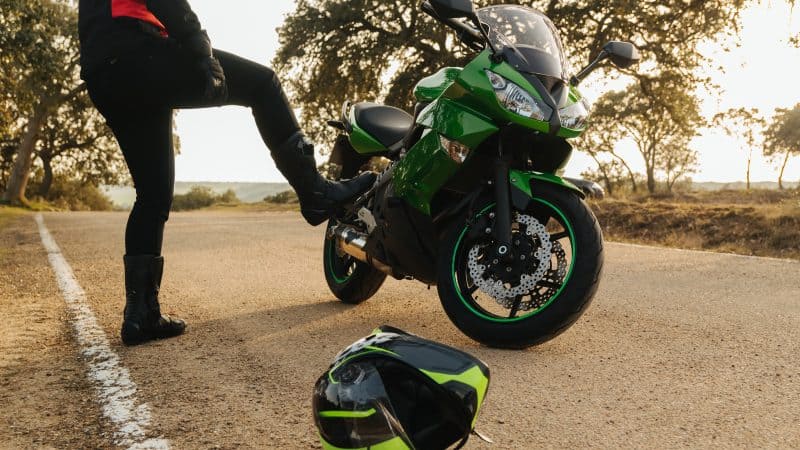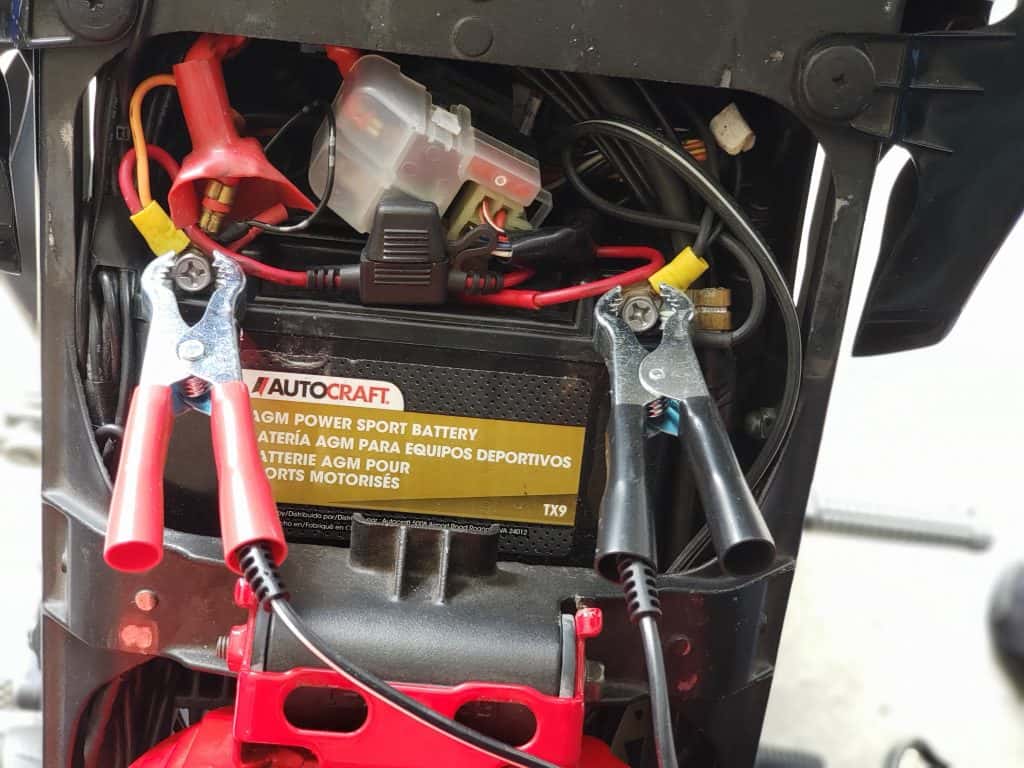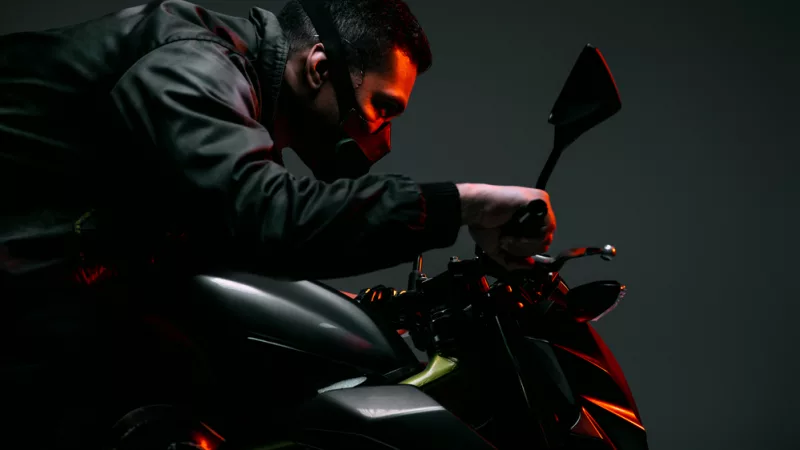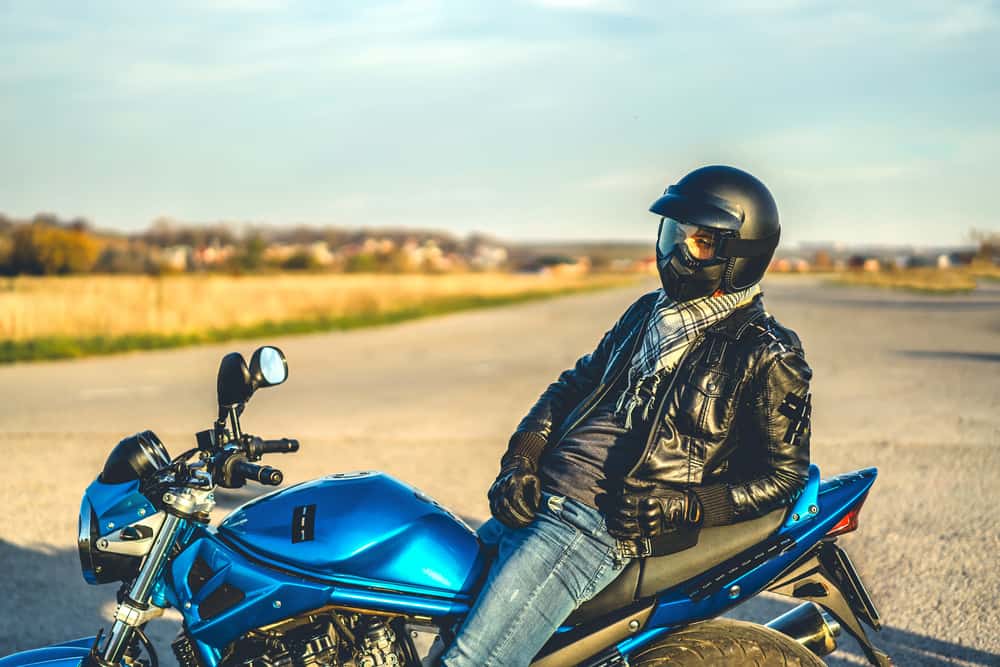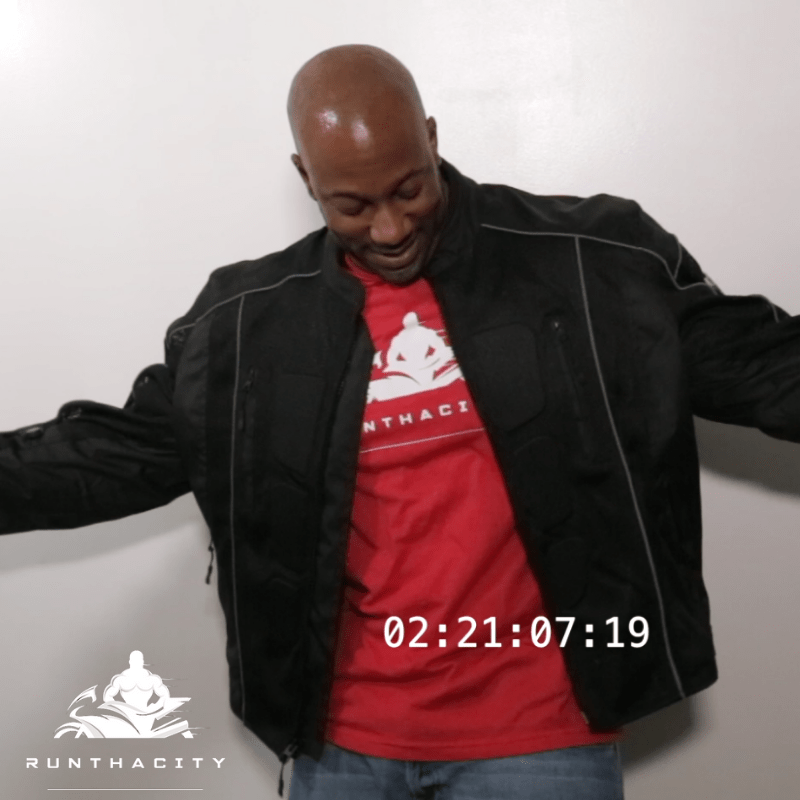When it comes to motorcycle jackets, you want something that balances the need to look like you own the road and enough protection to keep you from becoming part of the road. Viking Cycle, a brand based out of California, has been turning heads with their attention to detail and security in their full range of motorcycle clothing for men and women. The best part is the price tag.
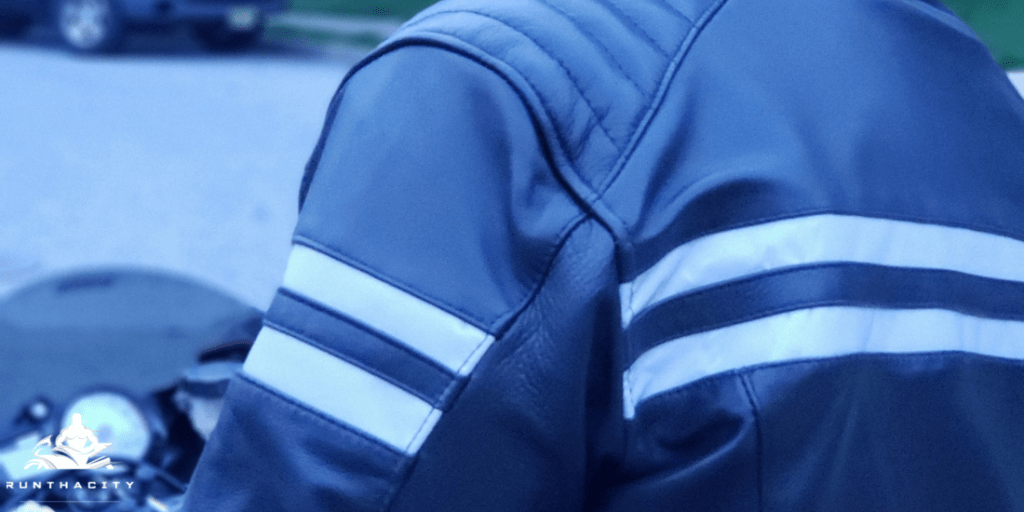
Overview of the Bloodaxe Motorcycle Jacket
Out of the box, the Bloodaxe looks awesome and feels awesome. When the jacket first goes on, you’ll notice it’s a bit stiff—but it does loosen up with some wear, as good leather should. The zippers have solid construction, open and close smoothly, and lay well when you’re riding.
The biggest advantage of the Viking Cycle Bloodaxe isn’t the awesome name but the amount of storage. You won’t believe the amount of storage space you have with this jacket. There’s so much, it’s almost ridiculous.
There is a headphone wire system that you can feed into the collar of the jacket, earphone pockets, a media player pocket, cellphone pocket with 3 second access, 2 knife and pen pockets, an eyeglass pocket, a pocket designed to find a 10-inch tablet, extendable keyholder, and another pocket that can fit travel documents and your wallet. The pockets have a unique “no bulge” design, so even if you somehow managed to stuff every single compartment this jacket has, it will still look flat and sleek and not like a bubble jacket. Overall, it sits nice on the body and doesn’t feel stifling.
The sizing does run a little small. Someone around 5 foot, 10 inches, 180 pounds will fall into the M-L range, depending on how much you want to bundle up. If you take out the thermal lining or don’t want to wear a lot of clothing underneath, you might want to size down to prevent the jacket from floating on you.
No products found.
No products found.
Specifications
(listed adapted from vikingcycle.com)
- Construction – Drum-dyed soft genuine cowhide leather (milled buffalo), padded shoulders, and Viking cycle level 1 removable “armor” on elbows and spine; two intake vents on the top of the shoulders and exhaust vents in the back
- External Storage – 2 zippered chest pockets, 2 zippered side pockets, and a single sleeve pocket
- Internal Storage – 2 secured zippered pockets and a secret compartment
- Adjustability – waist snaps and sleeve zippers
- Visibility – High viz stripes located on the back and shoulders
Pros
- Sag and wrinkle resistant
- Wind and water resistant
- Abrasion resistant
- A ton of hidden pockets on the internal side of the jacket
- CE marked armor in the back and shoulders – comfortable and stays in place while riding around
- Budget-friendly cost without a lack of quality and safety
- Stylish design
Cons
- Can be hot – the jacket has a thermal lining and is heavy, so it can be oppressive in the summertime even with the vents open. For that reason, it might not be ideal for moving in slower paced traffic;
- CE armor level could be higher.
Warranty Info
Viking Cycle offers a 1 year manufacturer’s warranty on all of their products. This means that any defects or imperfections that you find are covered. The warranty does not cover wear and tear or damages caused from improper care.
This might raise some questions about durability, since some production errors or faults can take a few days or weeks to appear.
If you start to notice something odd going on with the jacket that you didn’t cause, you can contact Viking Cycle at info@vikingcycle.com with the order number and a photo of the defect to get an exchange or refund.
No products found.
Conclusion
Honestly, for the quality of the jacket, you would expect to pay more for it than you do. The name might be a bit for metal than what this motorcycle jacket offers, but the sleekness of the design, paired with the sound construction and unheard of amount of storage makes it a clear winner. If you’re looking for a balance of style and safety without breaking your bank, I recommend the Viking Bloodaxe motorcycle jacket for your wardrobe.
Looking for more details about choosing motorcycle jackets and other riding gear? Then check out and subscribe to my YouTube channel today!
No products found.
No products found.
You Might also like
-
How to Properly Maintain Your Sportbike
Understanding the Importance of Sportbike Maintenance
Owning a sportbike is an exciting and rewarding experience, but it also comes with responsibilities. Proper maintenance is essential to ensure the longevity and performance of your bike, and to keep you safe on the road. In this comprehensive guide, we’ll explore the key components of sportbike maintenance and provide tips and tricks for keeping your bike in top condition.
Download RunThaCity’s General Sportbike Maintenance Schedule
Regular Maintenance Schedules: The Key to a Long-Lasting Sportbike
Regular maintenance is key to keeping your sportbike running smoothly and avoiding costly repairs down the road. The recommended maintenance schedule will vary depending on the make and model of your bike, as well as your riding style. Make sure to consult your owner’s manual for specific maintenance recommendations, and keep a record of all services and repairs performed on your bike. It’s always a good idea to perform routine checks on your sportbike to catch any potential issues early on. This can include checking fluid levels, the condition of hoses and belts, and the general state of the bike’s components.
Engine Oil and Filter Changes
One of the most important components of sportbike maintenance is regular engine oil and filter changes. Engine oil keeps your engine lubricated and prevents wear and tear, while the oil filter removes impurities from the oil. Oil changes should be performed at the intervals specified in your owner’s manual, and you should always use high-quality, recommended engine oil and filters. Skipping oil changes or using low-quality oil can cause serious damage to your engine, reduce fuel efficiency, and negatively impact performance.
Air Filter Cleaning or Replacing
The air filter is responsible for removing dirt and debris from the air that enters the engine. Dirty air filters can cause poor engine performance, reduced fuel efficiency, and even engine damage. Clean or replace your air filter at the intervals specified in your owner’s manual, or more often if you frequently ride in dusty or dirty conditions. Cleaning or replacing the air filter is a simple and inexpensive process that can greatly improve the performance and longevity of your sportbike.
Brake System Maintenance
The brake system is one of the most critical components of your sportbike, and proper maintenance is essential for safety. Regular brake inspections should be performed, and brake pads should be replaced as soon as they show signs of wear. The brake fluid should also be checked and replaced at the intervals specified in your owner’s manual. Worn or contaminated brake fluid can cause braking problems, and can negatively impact the overall performance of your brake system.
Tires
Tires are the only point of contact between your sportbike and the road, and they play a crucial role in handling and safety. Regular tire inspections should be performed, and tires should be replaced as soon as they show signs of wear or damage. Make sure to check the tire pressure regularly, as underinflated tires can cause handling problems and reduce fuel efficiency. Tires should also be rotated regularly to ensure even wear and extend their lifespan.
Battery Maintenance
Sportbike batteries can be expensive to replace, and proper maintenance is essential to extend their lifespan. Regular battery inspections should be performed, and batteries should be charged regularly if they are not being used. Make sure to disconnect the battery before performing any maintenance on your bike to avoid electrical problems. A battery that is not properly maintained can fail unexpectedly, leaving you stranded on the road.
Chain Maintenance
The chain is an essential component of your sportbike’s drivetrain, and proper maintenance is essential for smooth and efficient operation. Regular chain inspections should be performed, and the chain should be lubricated at the intervals specified in your owner’s manual. Make sure to use continue high-quality chain lubricant, and avoid getting lubricant on the brakes or tires. A worn or poorly lubricated chain can cause performance problems and even cause damage to other components of the drivetrain.
Suspension Maintenance
The suspension system of a sportbike plays a critical role in handling, comfort, and safety. Regular suspension inspections should be performed, and components should be replaced as soon as they show signs of wear or damage. Make sure to check the suspension settings and adjust them as necessary to match your riding style and the conditions you’ll be riding in. A poorly maintained suspension system can cause handling problems, reduce comfort, and negatively impact your overall riding experience.
Electrical System Maintenance
The electrical system of your sportbike is responsible for powering all of the bike’s components and accessories. Regular electrical system inspections should be performed, and components should be replaced as soon as they show signs of wear or damage. Make sure to check the battery, charging system, and all electrical connections for any signs of corrosion or damage. A poorly maintained electrical system can cause performance problems, reduce reliability, and even leave you stranded on the road.
Body and Fairing Maintenance
The body and fairing of your sportbike not only protect you from the wind and debris but also give your bike its signature look. Regular body and fairing inspections should be performed, and components should be replaced as soon as they show signs of wear or damage. Make sure to wash your sportbike regularly, and use high-quality wax or polish to protect the paint and prevent fading. A poorly maintained body and fairing can reduce the overall value of your bike, and make it more vulnerable to damage from the elements.
Conclusion:
Owning a sportbike is an exciting and rewarding experience, but it also comes with responsibilities. Proper maintenance is essential to ensure the longevity and performance of your bike, and to keep you safe on the road. By following the tips and tricks outlined in this comprehensive guide, you can keep your sportbike running smoothly, avoid costly repairs, and ensure that your riding experience is as enjoyable and safe as possible. Whether you’re an experienced rider or a newcomer to the sport, taking the time to properly maintain your sportbike is a worthwhile investment in your enjoyment and safety on the road.
-
Unveiling the Reality of Motorcycle Face Masks: Protection, Comfort, and the Road Ahead
The wind whipping past your face, the rumble of the engine beneath you, the feeling of freedom as you navigate the open road – motorcycles offer an unparalleled experience that exhilarates the soul. However, this sense of liberation comes hand-in-hand with inherent risks. Unlike car drivers enclosed in a metal cage, motorcyclists are directly exposed to the elements and potential hazards on the road.
According to the National Highway Traffic Safety Administration (NHTSA), motorcyclists are 27 times more likely to be killed in a crash than occupants of passenger vehicles. While helmets play a crucial role in mitigating head injuries, facial injuries remain a significant concern for motorcycle riders. This is where motorcycle face masks emerge as a potential solution, sparking questions and sparking interest within the riding community.
Despite their growing popularity, there’s a lack of widespread knowledge and understanding surrounding motorcycle face masks. Are they truly effective in enhancing safety and comfort? What are the different types available, and how do you choose the right one for your needs? This article delves into the unveiling reality of motorcycle face masks, exploring their benefits, drawbacks, and crucial considerations to guide you towards informed decision-making.
Key Takeaways
- Motorcycle face masks offer potential benefits like increased protection from debris, elements, and improved comfort, but they also have drawbacks like reduced airflow and fogging.
- Choose the right mask based on your riding style, needs, and preferences, prioritizing breathability, material, and a snug fit.
- Motorcycle face masks are not a substitute for proper safety gear and responsible riding practices.
Comparison Table: Full-Face vs. Half-Face Motorcycle Face Masks
Feature Full-Face Mask Half-Face Mask Coverage Entire face, head, and often neck Nose and mouth Protection Most comprehensive Limited Breathability Lower Higher Comfort Can be less comfortable, especially in hot weather More comfortable Communication May be challenging Easier Cost Generally more expensive Generally more affordable Types of Motorcycle Face Masks
Types of Motorcycle Face Masks
The world of motorcycle face masks offers a variety of options to cater to different preferences and riding styles. Here’s a breakdown of the two main categories, along with their unique characteristics:
1. Full-Face Masks:
- Comprehensive Protection: Full-face masks, resembling motorcycle helmets with a clear visor, provide the most extensive coverage. They shield the entire face, head, and often the neck, offering superior protection against:
- Impact: In the unfortunate event of an accident, a full-face mask acts as a barrier against road debris, gravel, and potential impacts, minimizing the risk of facial injuries.
- Elements: Full-face masks shield riders from wind, dust, rain, snow, and other harsh weather elements, enhancing comfort and visibility on long journeys.
- Insects: They provide a welcome shield against flying insects, especially beneficial for riders in areas with heavy bug populations.
- Enhanced Visibility (Optional): Certain models come equipped with integrated anti-fog features and a clear, wide visor, ensuring optimal visibility in various weather conditions.
- Drawbacks:
- Limited Airflow: Full-face masks can restrict airflow, leading to potential discomfort and fogging issues, especially in hot weather or during strenuous riding.
- Communication Challenges: Communicating with fellow riders or pedestrians might be hindered, particularly with models that lack integrated communication systems.
2. Half-Face Masks:
- Breathability and Comfort: Unlike their full-face counterparts, half-face masks prioritize breathability and comfort. They come in various designs, including:
- Bandanas: These versatile and affordable options offer basic protection for the nose and mouth, often made from breathable materials like cotton or synthetic blends.
- Balaclavas: These full-head coverings, often made from moisture-wicking fabrics, provide warmth and protection for the face, ears, and neck, particularly suitable for cold weather riding.
- Specialized Masks: Options exist for specific needs, such as dust masks for off-road riding or cold weather masks with windproof and thermal properties.
- Benefits:
- Affordability: Half-face masks are generally more affordable compared to full-face masks.
- Comfort: They offer superior breathability, reducing the risk of overheating and fogging, making them ideal for hot weather conditions.
- Limitations:
- Reduced Protection: Half-face masks offer limited protection compared to full-face options, leaving the eyes, forehead, and cheeks exposed to potential impacts and weather elements.
Choosing the right type of motorcycle face mask boils down to your individual needs and riding style. Consider factors like the level of protection desired, weather conditions in your riding environment, and personal preferences for comfort and breathability.
Benefits of Using Motorcycle Face Masks
While the decision to wear a motorcycle face mask ultimately depends on personal preference and riding style, there are several potential benefits to consider:
Enhanced Safety:
- Reduced Injury Risk: Face masks offer an extra layer of protection against road debris, gravel, and small objects that could potentially cause facial injuries during a fall or collision. While not a substitute for proper riding gear and safe riding practices, they can minimize the potential for cuts, scrapes, and abrasions.
- Improved Visibility: Certain full-face masks with clear visors can actually improve visibility by shielding your eyes from dust, wind, and rain. This can be particularly beneficial during long rides or in weather conditions that might impair vision.
Increased Comfort and Enjoyment:
- Protection from the Elements: On longer journeys, exposure to wind, dust, and harsh weather elements can become uncomfortable. Motorcycle face masks provide a shield against these elements, helping to maintain a more pleasant and comfortable riding experience.
- Reduced Fatigue: Dust and windblown particles can contribute to eye irritation and fatigue, especially over extended periods. Face masks can effectively minimize these issues, allowing you to stay focused and refreshed for a longer ride.
- Sun Protection: While not all masks offer this benefit, some materials provide a degree of UV protection, helping to shield your face from the sun’s harmful rays, especially relevant for riders in sunny regions.
It’s important to remember that motorcycle face masks are not a replacement for safe riding practices and proper safety gear like helmets. However, when used responsibly and in conjunction with other safety measures, they can offer additional benefits and contribute to a more enjoyable and potentially safer riding experience.
Drawbacks and Considerations
While motorcycle face masks offer potential benefits, there are also drawbacks and important considerations to keep in mind before making a purchase:
Drawbacks:
- Reduced Airflow and Fogging: Full-face masks, especially those lacking proper ventilation features, can restrict airflow, leading to discomfort and potentially causing the visor to fog, particularly in hot or humid weather.
- Communication Challenges: Full-face masks can hinder communication with other riders or pedestrians, especially if they lack integrated communication systems or have features that muffle speech.
- Limited Effectiveness in High-Speed Crashes: While offering some protection against debris and minor impacts, it’s crucial to remember that motorcycle face masks are not rigorously tested to the same standards as helmets and might not offer significant protection in high-speed crashes.
Considerations:
- Legality: Regulations regarding motorcycle face masks vary by region. It’s essential to check the local laws in your area to ensure their use is legal before making a purchase.
- Material and Breathability: Choose masks made from breathable materials that prioritize both protection and air circulation to minimize discomfort and fogging.
- Fit and Comfort: A snug but comfortable fit is crucial for proper protection and preventing fogging. Ensure the mask doesn’t restrict your vision or head movement excessively.
- Safety Certifications: Unlike motorcycle helmets that have established safety standards (e.g., DOT, ECE), there are currently no specific safety certifications for motorcycle face masks. Choose reputable brands and prioritize masks made from high-quality materials for greater peace of mind.
By understanding these drawbacks and considerations, you can make an informed decision that aligns with your individual needs and prioritizes safety on the road.
Choosing the Right Motorcycle Face Mask
Navigating the world of motorcycle face masks can feel overwhelming with diverse options available. Here’s a guide to help you select the perfect mask for your riding style:
1. Identify Your Needs and Riding Style:
The first step is to understand your individual needs and the type of riding you primarily engage in. Consider the following:
- Protection Level: Do you prioritize comprehensive protection for frequent highway rides, or is basic coverage sufficient for occasional commutes?
- Weather Conditions: Will you be riding primarily in hot weather, requiring maximum breathability, or do you face frequent cold and require wind protection?
- Comfort Preferences: Do you prioritize a lightweight, barely-there feel, or are you comfortable with a mask offering more substantial coverage?
2. Prioritize Breathability and Material:
Breathability is crucial for comfort and preventing fogging. Choose masks made from:
- Moisture-wicking fabrics: These fabrics like polyester or merino wool effectively manage sweat and prevent discomfort, especially during warm weather riding.
- Mesh materials: Ideal for hot weather, mesh masks offer superior breathability while still providing basic protection against dust and debris.
3. Ensure a Proper Fit:
A snug but comfortable fit is essential for both safety and preventing fogging. The mask should:
- Securely fit around your face without being overly tight or restrictive.
- Not obstruct your vision or head movement in any way.
- Offer a good seal around the edges to prevent dust and wind infiltration.
4. Consider Additional Features:
Depending on your needs, you might find these features beneficial:
- Visor: For full-face masks, choose a clear, anti-fog visor to ensure optimal visibility in various weather conditions.
- Ventilation: Look for masks with strategically placed vents to promote airflow and reduce fogging.
- Removable filters: Some masks offer replaceable filters for additional protection against dust and allergens.
5. Remember, Safety First:
While motorcycle face masks can offer benefits, they are not a substitute for proper safety gear like helmets and protective clothing. Always prioritize safe riding practices and responsible decision-making on the road.
By following these steps and considering your individual needs and preferences, you can choose the best motorcycle face mask to enhance your riding experience while prioritizing your well-being on the road.
6 FAQs About Motorcycle Face Masks
6 FAQs About Motorcycle Face Masks
1. Are motorcycle face masks required by law?
The legal regulations regarding motorcycle face masks vary by region. It’s crucial to check the local laws in your area before using one.
2. What materials are best for motorcycle face masks?
Choose masks made from breathable materials like moisture-wicking fabrics (polyester, merino wool) or mesh for hot weather, prioritizing both protection and airflow.
3. How do I prevent my motorcycle face mask from fogging?
Look for masks with anti-fog visors and proper ventilation. Ensure a snug fit and avoid touching the inside of the visor with your gloves.
4. Can I wear a motorcycle face mask with a helmet?
Yes, most motorcycle face masks are designed to be worn comfortably under a helmet. However, ensure compatibility and a proper fit to avoid discomfort or restricted movement.
5. Where can I buy a motorcycle face mask?
Motorcycle face masks can be found at motorcycle dealerships, online retailers, and outdoor gear stores.
6. Are motorcycle face masks effective against COVID-19?
While some motorcycle face masks might offer basic protection against airborne particles, they are not certified medical equipment and should not be solely relied upon for COVID-19 prevention. Always follow official health guidelines and recommendations.
Facts & Statistics: Motorcycle Usage and Face Mask Preferences
- 70% of motorcycle owners use their bikes for leisure riding. (https://www.statista.com/study/91633/motorcycles-report/)
- 30% of motorcycle owners commute to work on their bikes. (https://www.statista.com/study/91633/motorcycles-report/)
- There are currently no established safety certifications for motorcycle face masks.
Conclusion
The world of motorcycle riding is an exhilarating experience, but it also comes with inherent risks. Motorcycle face masks have emerged as a potential solution, offering additional protection and comfort for riders. However, it’s crucial to approach them with a balanced perspective, acknowledging both their benefits and drawbacks.
This article has provided a comprehensive overview of different types of motorcycle face masks, their potential advantages and limitations, and crucial factors to consider when making a choice. Remember, the ideal mask depends on your individual needs, riding style, and comfort preferences.
Ultimately, safe riding practices and prioritizing safety gear remain paramount. Consider motorcycle face masks as a potential complement to your existing safety measures, not a replacement. By making informed choices and prioritizing your well-being, you can ensure a more enjoyable and potentially safer journey on the open road.
-
Viking Cycle – Warlock Textile Motorcycle Jacket Review
Finding a Great Entry-Level Cycle Jacket - Viking Warlock Jacket Review
When critiquing motorcycle jackets, we have a tendency to judge them by the standards and needs of long-term, experienced cyclists. The unfortunate truth is that, for those just getting into motorcycling, these criteria may be a good bit different. For one thing, beginners will tend to spend somewhat less time on their bikes as they’re still getting a feel for them, and they’re less likely to be out there in the more extreme temperatures of high summer and mid-winter.
This means that some forgiveness in fitting and materials is called for when looking at a prospective first motorcycle jacket. In the case of the VikingCycle’s Warlock jacket, this may work out pretty well.
No products found.
The Look Of The Warlock Jacket
Well, let’s be honest with ourselves, we’re always going to demand that our jacket look really cool. It won’t do to look unstylish on our bikes, no matter if we’re a novice or a years-experienced rider. If the jacket doesn’t look good, nothing else matters. Maybe this isn’t the most prioritized way to think of things, but that’s just how it is.
While not the classic cruiser style so iconic in pop culture, this jacket does have a very modern classic vibe to it. It achieves a contemporary, unassuming but stylish look that blends many of the safety and comfort features of sport/street jackets, with the gentle form hugging and sleek nature that makes those cruiser jackets so beloved in the first place.
Moving forward, this even blend of these two styles will probably be somewhat timeless, which gives this jacket a unique future proof nature.
Comfort in a motorcycle jacket is a delicate balance. You don’t want to feel claustrophobic in the jacket, but at the same time, something too loose would have obvious problems. Similarly, you don’t want it to feel too bulky or heavy, but you want to feel like you’ve got something on. Finally, you want this balanced comfort to also provide good wind-cutting power, especially when it’s chilly out. Remember, the faster you go, the colder that air is going to be.
This jacket checks all but one of these boxes rather nicely. I felt like I had a solid jacket on, but I never felt claustrophobic, encumbered nor weighed down by it. The adjustable sleeves and collar meant that I didn’t feel like my circulation was cut off, but it still sealed me up well enough against the elements.
Unfortunately, the wind-cutting power of this jacket isn’t phenomenal, even with the liner in. It’s far from the worst, but in particularly chilly weather, the wind is still going to bite right into you with this jacket.
Motorcycle Jacket Safety
Safety is of course a big concern, especially for a beginner. This jacket manages to be pretty well-padded and abrasion-resistant, without feeling cumbersome. Granted, it’s not as fortified as a racing jacket, but I felt very safe in this jacket, especially thanks to the waist zipper that fastens to pants to provide a unified layer of protection.
It definitely passes my standards for safety, no question there.
VikingCycle’s Signature Rain Gear Fabric is a 100% 600D Polyester coated by PU (polyurethane). The 600D Polyester coated by PU, is also wind and water resistant so it will provide great protection against cold wind and rain and it will not sag and creates less wrinkle overtime. The fabric is light weight but highly resilient against abrasions to provide more resistance between the body and the road for your protection, and also stands against wear and tear for product durability.
No products found.
Bells and Whistles
Finally, we come to the additional accoutrements this jacket offers. It’s not the most elaborate design out there, but it’s not without its charms.
- Large zipper tabs make it easy to operate the zippers with gloves on – something that can be exquisitely frustrating.
- Plenty of inside pockets for your phone, your wallet, etc. where they’re protected from the elements and impacts.
- Removable liner makes this jacket comfortable for warm and cool riding.
Warlock Jacket Textile Motorcycle Jacket Overview
No products found.
Pros and Cons
Pros
- This is an affordable jacket, especially for the quality, which is a major deciding factor for the beginner motorcyclist.
- The inside pockets are a nice touch.
- The neutral, non-aggressive style is timeless, contemporary and pairs with any style of bike.
- The zippers are phenomenal.
Cons
- Removable liner takes most of the inner pockets with it, and doesn’t cut wind well.
- Velcro is used in stead of button clasps – this is a noisy material that wears out and accumulates “fuzz”.
- There are synthetic materials in the cuffs that may be less durable.
Warranty Information
VikingCycle takes the highest pride to provide the best motorcycle gear craftsmanship and material in the world. We always stand behind all our product quality. If you experience any manufacturing defects on any of our items, please let us know and return it for a replacement within 1 year of purchase.
This warranty does not cover any item damage due to normal wear and tear or improper care. Normal wear and tear is unavoidable and it is a sign that the product has been worn, such as small scratches or color change.
To claim any manufacturing defect warranty and to get your replacement as soon as possible, please let us know by emailing us at info@vikingcycle.com with your order number and a photo of the product defect.
Conclusion
This jacket’s not perfect, but then, is anything ever truly perfect? As a seasoned rider, I’d personally purchase this jacket. It is affordable, comfortable and a stylish first jacket for a beginner? I’d definitely be happy recommending the Warlock jacket.
To purchase, click here:
No products found.
To learn more about choosing the ideal motorcycle jacket for your needs, subscribe to my YouTube channel today!
No products found.

